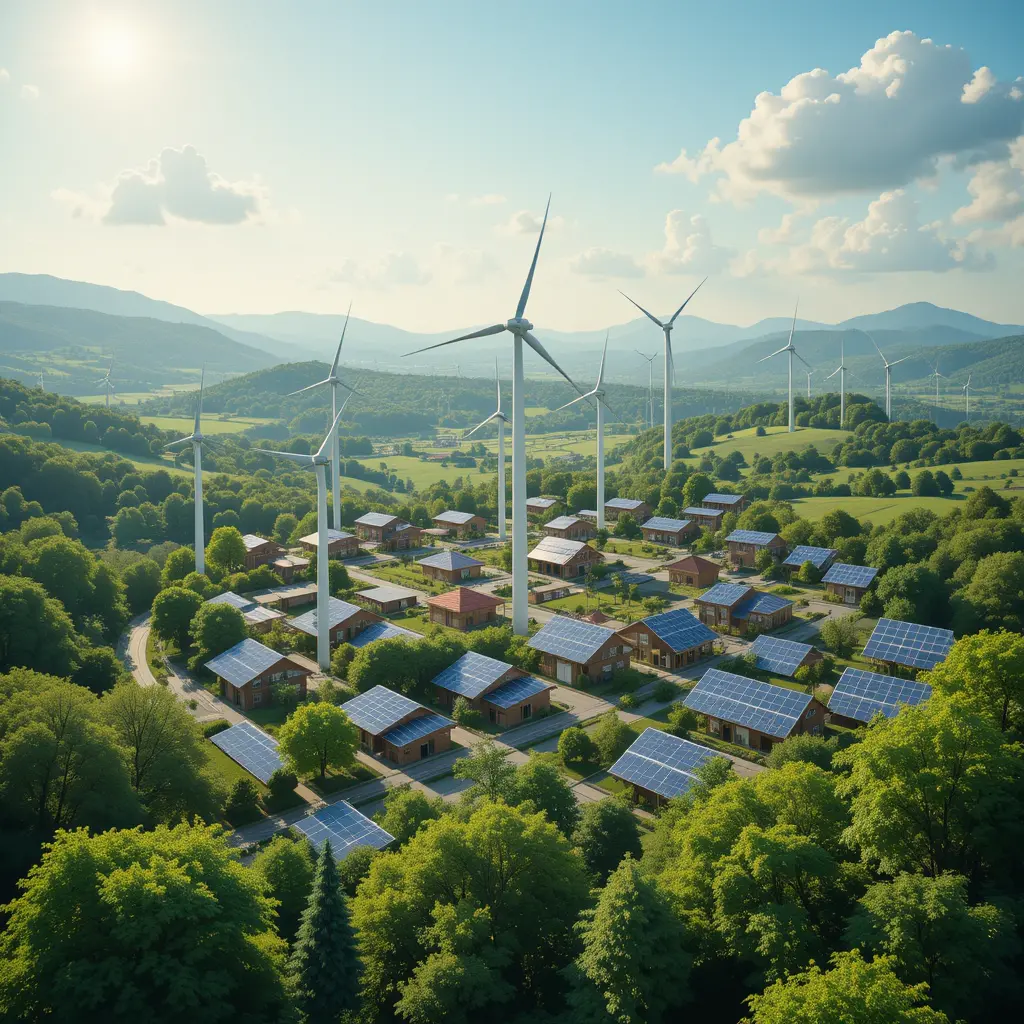Imagine a world where the air is cleaner, the skies are clearer, and energy is abundant and sustainable. Renewable energy holds the promise of transforming this vision into reality. As climate change accelerates, the need for clean energy sources becomes more urgent. This article explores how renewable energy can play a crucial role in reducing carbon emissions and combating climate change. Discover the potential of solar, wind, and other renewable technologies to reshape our future and protect our planet.
Understanding Renewable Energy
Renewable energy is a fascinating topic that has gained significant attention in recent years. As a Renewable Energy Expert, I often find myself explaining its importance to friends and family. Imagine a world where our energy comes from the sun, wind, and water. This isn’t just a dream; it’s a reality we are working towards. The role of renewable energy in combating climate change is crucial, and understanding it is the first step in making a difference.
What is Renewable Energy?
Renewable energy comes from natural sources that replenish themselves over time. Think of the sun shining every day or the wind blowing across open fields. These sources are abundant and, importantly, they don’t run out. Unlike fossil fuels, which take millions of years to form, renewable energy is always available. This makes it a sustainable choice for the future.
One of my favorite examples is solar panels. They capture sunlight and convert it into electricity. It’s like having a mini power plant on your roof! I remember visiting a solar farm and being amazed at how simple yet effective the technology is. It made me realize how accessible renewable energy can be.
Why Does It Matter?
The role of renewable energy in combating climate change cannot be overstated. By reducing our reliance on fossil fuels, we decrease greenhouse gas emissions. This helps slow down global warming and its devastating effects. I believe that every small step towards using renewable energy counts. It’s like planting a tree; one might not seem like much, but together, they create a forest.
In my experience, people often underestimate the impact they can have. Switching to renewable energy sources, even on a small scale, contributes to a larger movement. It’s empowering to know that our choices can lead to a healthier planet.
Understanding renewable energy is not just about technology; it’s about envisioning a better future. It’s about making informed decisions that benefit both us and the environment. As we continue to explore and innovate, I am hopeful that renewable energy will become the norm, paving the way for a sustainable world.
Types of Renewable Energy Sources
Renewable energy sources are essential in our fight against climate change. They offer sustainable alternatives to fossil fuels, reducing carbon emissions and promoting environmental health. As a Renewable Energy Expert, I believe that understanding these sources is crucial for a greener future.
Solar Energy
Solar energy harnesses the power of the sun to generate electricity. Imagine a sunflower turning its face to the sun, capturing its warmth. Similarly, solar panels absorb sunlight and convert it into usable energy. This method is not only clean but also abundant. I remember visiting a solar farm in California, where rows of panels stretched as far as the eye could see. It was a testament to the potential of solar energy in reducing our carbon footprint.
Wind Energy
Wind energy utilizes the natural movement of air to produce power. Picture a child flying a kite on a breezy day, feeling the wind’s force. Wind turbines work on the same principle, converting kinetic energy into electricity. In my opinion, wind energy is a powerful ally in combating climate change. During a trip to Denmark, I was amazed by the sight of offshore wind farms, their blades gracefully spinning against the horizon. This experience reinforced my belief in the role of renewable energy in combating climate change.
These renewable sources, among others, play a vital role in our efforts to combat climate change. By embracing solar and wind energy, we can pave the way for a sustainable future. Let’s continue to explore and invest in these technologies for the sake of our planet.
Benefits of Renewable Energy
Renewable energy is not just a buzzword; it’s a lifeline for our planet. As a Renewable Energy Expert, I often find myself marveling at how these natural power sources can transform our world. Imagine a future where our children breathe cleaner air and enjoy a stable climate. This is the promise of renewable energy.
Environmental Benefits
One of the most significant advantages of renewable energy is its ability to reduce our carbon footprint. By harnessing the power of the sun, wind, and water, we can significantly cut down on greenhouse gas emissions. For instance, solar panels on rooftops not only generate electricity but also symbolize a commitment to a healthier planet. I remember visiting a community that had embraced solar energy, and the pride in their eyes was unmistakable. They knew they were making a difference.
Economic Advantages
Switching to renewable energy also brings economic benefits. It creates jobs in manufacturing, installation, and maintenance. In my experience, regions that invest in sustainable energy often see a boost in local economies. This shift not only supports the environment but also empowers communities. I once spoke with a young engineer who found his passion in wind energy. His enthusiasm was contagious, and it reminded me of the potential for growth in this sector.
The role of renewable energy in combating climate change is undeniable. It offers a path to a more sustainable future, where we can enjoy the benefits of modern life without compromising the health of our planet. As we continue to innovate and invest in these technologies, I am hopeful that we will see a brighter, cleaner world for generations to come.
Challenges in Implementing Renewable Energy
Implementing renewable energy is crucial in our fight against climate change. However, the journey is not without its hurdles. As a Renewable Energy Expert, I have witnessed firsthand the complexities involved in this transition. From financial constraints to technological challenges, the path is fraught with obstacles. Yet, the potential benefits make it a journey worth pursuing.
Financial and Technological Barriers
One of the most significant challenges is the financial investment required to develop renewable energy infrastructure. Many regions struggle to secure the necessary funding. For instance, small communities often lack the resources to invest in solar panels or wind turbines. This financial hurdle can slow down the energy transition, delaying the benefits of cleaner energy.
Technological challenges also play a role. The integration of renewable energy sources into existing grids can be complex. I recall a project where the local grid couldn’t handle the additional load from a new wind farm. It required significant upgrades, which took time and money. These technological barriers can be daunting, but they are not insurmountable.
Social and Political Challenges
Social acceptance is another hurdle. People are often resistant to change, especially when it involves new technology. I once worked on a solar project where the community was initially opposed due to misconceptions about its impact. Through education and engagement, we managed to change their perspective, but it took time and effort.
Political factors also influence the implementation of renewable energy. Policies and regulations can either support or hinder progress. In some cases, political interests may favor traditional energy sources, creating additional challenges for renewable projects. Navigating these political landscapes requires patience and strategic planning.
Despite these challenges, the role of renewable energy in combating climate change is undeniable. With perseverance and innovation, we can overcome these obstacles and pave the way for a sustainable future. The journey may be tough, but the rewards are worth the effort.
The Future of Renewable Energy
The future of renewable energy is a topic that sparks both excitement and curiosity. As a Renewable Energy Expert, I often find myself pondering the vast potential that lies ahead. The role of renewable energy in combating climate change is undeniable, and its importance grows with each passing day. Imagine a world where clean energy sources power our homes, cars, and industries. This vision is not just a dream; it’s becoming a reality.
Innovations in Renewable Energy Technology
Recent advancements in renewable energy technology are paving the way for a more sustainable future. Solar panels, for instance, have become more efficient and affordable. I remember visiting a solar farm last year, where I witnessed firsthand the incredible power of the sun being harnessed to generate electricity. It was a moment of awe and inspiration. Wind turbines, too, are evolving, with designs that capture more energy even in low-wind areas. These innovations are crucial as we strive to reduce our reliance on fossil fuels.
Global Energy Policies and Their Impact
Global energy policies play a significant role in shaping the future of renewable energy. Countries worldwide are setting ambitious targets to increase their renewable energy capacity. I believe these policies are essential for driving change. However, they must be implemented effectively to make a real difference. During a conference I attended, experts discussed the challenges and opportunities in aligning these policies with technological advancements. It was clear that collaboration between nations is key to achieving our climate goals.
In conclusion, the future of renewable energy holds immense promise. With continued innovation and supportive global energy policies, we can create a cleaner, more sustainable world. As we move forward, it’s important to remember that each step we take brings us closer to a brighter future. Let’s embrace this journey with hope and determination.
Conclusion
As we reach the end of our exploration into renewable energy, it’s clear that its role in combating climate change is not just significant but essential. The journey towards a sustainable future is akin to steering a ship through turbulent waters. We must remain steadfast and committed to our course.
The Role of Renewable Energy in Combating Climate Change
Renewable energy sources, like solar and wind, are the lifeboats in our fight against climate change. They offer a cleaner, more sustainable alternative to fossil fuels. I remember visiting a small town that had embraced solar power. The transformation was remarkable. The air felt cleaner, and the community was thriving. This experience reinforced my belief in the power of renewables.
In my opinion, the transition to renewable energy is not just a technical challenge but a societal one. We need to change how we think about energy consumption. It’s like teaching an old dog new tricks. It takes time, patience, and a lot of effort. But the rewards are worth it. Imagine a world where our children can breathe clean air and enjoy a stable climate. That’s the future we should strive for.
In conclusion, the role of renewable energy in combating climate change is undeniable. It’s a beacon of hope in a world that desperately needs it. As a renewable energy expert, I am optimistic about the future. With continued innovation and commitment, we can turn the tide and create a sustainable world for generations to come.






